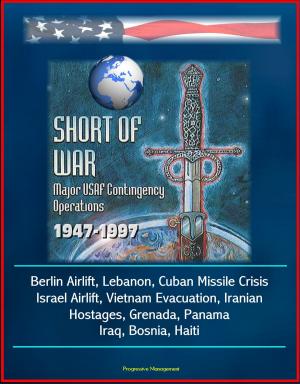Evolution of Warfare: Military Course on the Art and Concepts of Warfare From The Beginning of Recorded History - Classical Macedonians and Romans, Prussian Influence, American Civil War, World Wars
Nonfiction, History, Military, United States| Author: | Progressive Management | ISBN: | 9781310920417 |
| Publisher: | Progressive Management | Publication: | June 10, 2014 |
| Imprint: | Smashwords Edition | Language: | English |
| Author: | Progressive Management |
| ISBN: | 9781310920417 |
| Publisher: | Progressive Management |
| Publication: | June 10, 2014 |
| Imprint: | Smashwords Edition |
| Language: | English |
This is a unique Navy course in Evolution of Warfare. The course is a survey of the operational art of warfare from the beginning of recorded history to the present. The three volumes of lesson guides are intended to assist the NROTC Marine Officer Instructors to develop more personalized/ detailed lesson plans.
The purpose of the Evolution of Warfare course is to provide a very basic understanding of the art and concepts of warfare from the beginning of recorded history to the present day. The intent of the curriculum is to familiarize the student (future Marine officers) with an understanding of the threads of continuity and the interrelations of political, strategic, operational, tactical, and technical levels of war from the past, while bringing into focus the application of these same principles and concepts to the battlefields of today and the future.
Throughout this course, military history is used as a means by which the future officer may challenge and question the decisions of the past. While the violence and uncertainty of the battlefield cannot be recreated, an appreciation for the complexities and dynamics posed by the art and science of warfare can be realized. Therefore, we must take the opportunities to learn lessons presented by the past, while acquiring knowledge of the present and future, in order to better anticipate future conflicts.
The curriculum guide is divided into three volumes and an instructor resource manual. Each volume facilitates a different type course. The individual instructor may decide which method is best suited for his/her particular educational situation. Throughout each volume, twelve chronological topic areas are common. The topic areas are designed to facilitate the integration of the material provided in different volumes. Instructors are encouraged to augment the material in one volume with material found in other volumes or elsewhere.
Topic Area 1: The Nature of War. Topic Area 2: Classical Warfare: Macedonians and Romans - The era of the ancient Greeks and Romans presents the first well-documented period of military history in the western world. Topic Area 3: Byzantine and Feudal Warfare (Mongol Warfare). Topic Area 4: The Age of Transition (15th and 17th Centuries) - The breakdown of the old feudal order and the emergence of the modern world had far reaching effects on warfare. Topic Area 5: The Revolutionary Period - While not all that remarkable from a purely military standpoint, the contrasting approaches of Washington and Greene are an interesting case study. One of the greatest of the military captains, Napoleon, capitalized on all that preceded him during the revolutionary period and forged one of the finest, most cohesive, and most responsive military instruments in history. The Grand Army, under his leadership, practiced maneuver warfare in a manner clearly reminiscent of the Mongols. Topic Area 6: American Civil War
Not only is the Civil War considered the first modern war in history, it affects American military thought and practice up to this very day. Topic Area 7: Pax Britannica and the Prussian Influence - As England's colonization program expanded and industrialization spread throughout Europe, North America, and Japan, the military potential of the nation-state increased exponentially. Topic Area 8: World War I. Topic Area 9: Interwar Years - The 1920's and 1930's were a period of reaction against the horrors of total war. The various attempts to limit war are examined. Topic Area 10: World War II - This topic is a broad and complex period to be totally analyzed. Topic Area 11: Post World War II - Strategic nuclear strategy, limited war, counterinsurgency/ revolutionary warfare, terrorism, continued technological progress, and the enduring value of maritime power are all subjects that are included in this topic. Topic Area 12: War Today.
This is a unique Navy course in Evolution of Warfare. The course is a survey of the operational art of warfare from the beginning of recorded history to the present. The three volumes of lesson guides are intended to assist the NROTC Marine Officer Instructors to develop more personalized/ detailed lesson plans.
The purpose of the Evolution of Warfare course is to provide a very basic understanding of the art and concepts of warfare from the beginning of recorded history to the present day. The intent of the curriculum is to familiarize the student (future Marine officers) with an understanding of the threads of continuity and the interrelations of political, strategic, operational, tactical, and technical levels of war from the past, while bringing into focus the application of these same principles and concepts to the battlefields of today and the future.
Throughout this course, military history is used as a means by which the future officer may challenge and question the decisions of the past. While the violence and uncertainty of the battlefield cannot be recreated, an appreciation for the complexities and dynamics posed by the art and science of warfare can be realized. Therefore, we must take the opportunities to learn lessons presented by the past, while acquiring knowledge of the present and future, in order to better anticipate future conflicts.
The curriculum guide is divided into three volumes and an instructor resource manual. Each volume facilitates a different type course. The individual instructor may decide which method is best suited for his/her particular educational situation. Throughout each volume, twelve chronological topic areas are common. The topic areas are designed to facilitate the integration of the material provided in different volumes. Instructors are encouraged to augment the material in one volume with material found in other volumes or elsewhere.
Topic Area 1: The Nature of War. Topic Area 2: Classical Warfare: Macedonians and Romans - The era of the ancient Greeks and Romans presents the first well-documented period of military history in the western world. Topic Area 3: Byzantine and Feudal Warfare (Mongol Warfare). Topic Area 4: The Age of Transition (15th and 17th Centuries) - The breakdown of the old feudal order and the emergence of the modern world had far reaching effects on warfare. Topic Area 5: The Revolutionary Period - While not all that remarkable from a purely military standpoint, the contrasting approaches of Washington and Greene are an interesting case study. One of the greatest of the military captains, Napoleon, capitalized on all that preceded him during the revolutionary period and forged one of the finest, most cohesive, and most responsive military instruments in history. The Grand Army, under his leadership, practiced maneuver warfare in a manner clearly reminiscent of the Mongols. Topic Area 6: American Civil War
Not only is the Civil War considered the first modern war in history, it affects American military thought and practice up to this very day. Topic Area 7: Pax Britannica and the Prussian Influence - As England's colonization program expanded and industrialization spread throughout Europe, North America, and Japan, the military potential of the nation-state increased exponentially. Topic Area 8: World War I. Topic Area 9: Interwar Years - The 1920's and 1930's were a period of reaction against the horrors of total war. The various attempts to limit war are examined. Topic Area 10: World War II - This topic is a broad and complex period to be totally analyzed. Topic Area 11: Post World War II - Strategic nuclear strategy, limited war, counterinsurgency/ revolutionary warfare, terrorism, continued technological progress, and the enduring value of maritime power are all subjects that are included in this topic. Topic Area 12: War Today.















